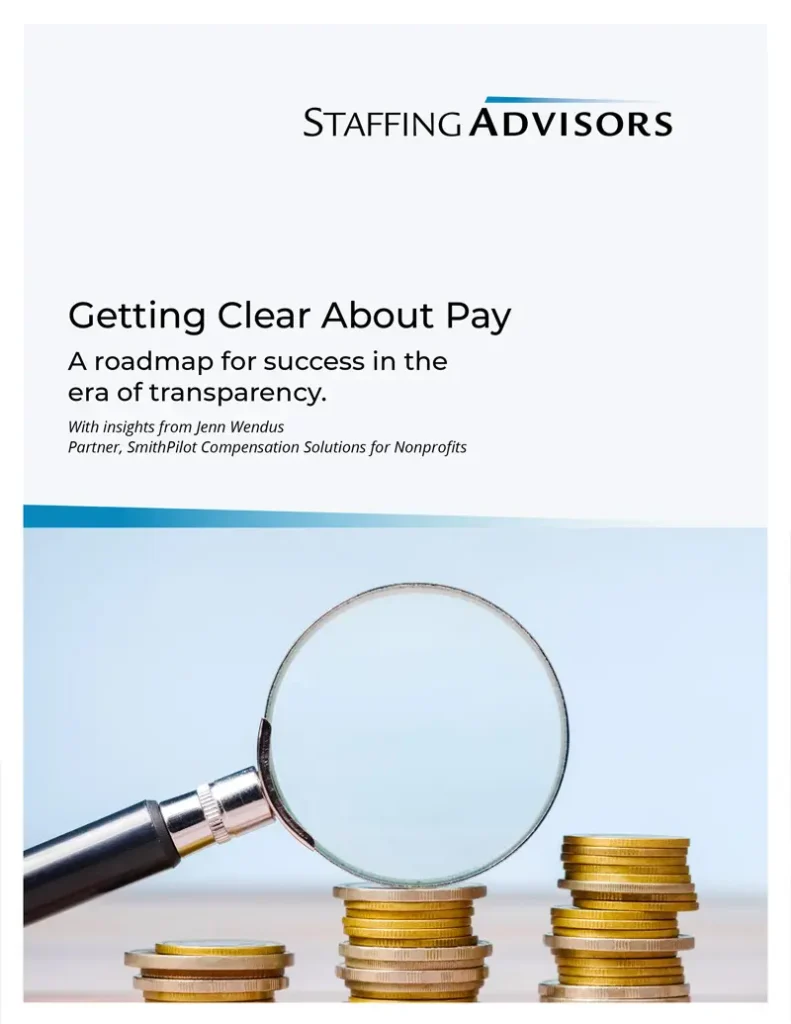The pay transparency movement is sweeping across the nation, bringing compensation into open dialogue and transforming how we think and talk about pay.
At Staffing Advisors, we’ve seen the complexities of how this can impact an organization. Even the simple act of posting salary in a job ad can be a double-edged sword, attracting highly qualified candidates on the one hand, while potentially exposing internal inequities on the other.
For our clients, we regularly work with compensation experts at SmithPilot to provide accurate market data and guidance on a range of compensation-related decisions. Jenn Wendus, SmithPilot Partner, graciously agreed to share broader advice on how to navigate new transparency legislation and other workplace changes related to pay.
What follows is a practical guide for not only embracing transparency but leveraging compensation practices to build trust, drive equity, and reinforce organizational values.

“Things were steady for a long time, but now everything has shifted for a lot of different reasons. Compensation affects so many aspects of HR and culture. Remote and hybrid models, new approaches to talent management—all of these are changing in tandem with one another. I’m thrilled to see more organizations working toward pay transparency.”
Jenn Wendus, SmithPilot Partner
Start With the Foundation: Formalize Your Approach
We asked Jenn about trends she’s seen among her nonprofit clients. She noted that while many were already moving towards openness, pay transparency legislation is accelerating that movement. Disclosing salaries in job ads, providing information about salary structures to staff, and bans on salary history inquiries are among the new requirements organizations in many states must meet. At the same time, employees and candidates are learning more about the topic of pay transparency and feel increasingly empowered to ask about pay.
There is a new dynamic taking hold, and it’s here to stay.
Jenn encourages all organizations to prepare to share more pay information, even if it’s not legally mandated. To do that effectively, you need a strategy and a framework to guide your compensation decisions. Basic components include:
- Developing consistent criteria for how pay is determined, such as skill set, tenure, performance, and relevant education or certifications
- Establishing salary ranges based on those criteria and current market rates
- Outlining clear practices for anything related to pay, including new hire salaries, raises, promotions, bonuses, etc.
- Setting up a system of regular reviews
A well-designed framework not only standardizes decisions and creates a baseline for equity, but it can also drive performance and engagement by fostering a culture where employees feel valued and understand how their contributions relate to their compensation.
Try this five factor framework. To spend your salary budget wisely, start with a salary survey and adjust using these five factors in combination. Read: Think Like a Compensation Pro.
The Next Step: Open the Lines of Communication
With your strategy and framework in place, it’s time to communicate internally. But sharing salary ranges and details about your compensation program isn’t enough. As with any significant change management initiative, this requires consistent messaging, training, and creating channels to address questions and concerns. Jenn recommends developing a strategic communication plan.
- Align leadership. Ensure the entire leadership team understands and can consistently communicate the compensation framework.
- Prepare supervisors. Offer comprehensive training and support to managers who will field questions from their teams.
- Communicate broadly with staff. Share the organization-wide approach to compensation with all employees.
- Have individual conversations. Facilitate one-on-one employee discussions with managers or HR to address individual concerns.
A step-by-step rollout prevents surprises, such as employees discovering salary information through external job postings—especially if that might reveal inequities that haven’t yet been addressed. Ideally, staff should learn about compensation directly from your organization.
“Communication really has an impact on how people feel about their compensation. In the absence of information, we make assumptions about how things work. I think that’s just human nature. Having a plan to communicate while thinking about audiences along the way, in my experience, leads to the most successful rollouts of increased pay transparency.”
Normalize It: Make Compensation Discussions Part of the Everyday
Jenn describes the move toward increased transparency as a journey, acknowledging that organizations will be at different stages depending on their size, previous compensation work, communication norms, and other factors.
Regardless of where you are on this path, be upfront. Explain where you are now, where you want to be, and your plans for getting there.
Make talking about pay a regular part of employee relations and talent management. Anytime your organization is doing things related to compensation, like setting budgets or conducting performance reviews, share what you are doing and why.
“Be honest about where your organization is in terms of its compensation program. And that may mean you can’t share all of the information yet. But if you try to hide or disguise information, people will know, especially if it’s different from how you typically communicate.”
Review Often: Live Your Pay Equity Practices
A key goal of setting your compensation framework is to ensure consistent and equitable practices. And sharing that information creates a system of accountability and trust. But these aren’t one-time accomplishments. Jenn emphasizes the importance of ongoing pay equity reviews.
“Pay equity scanning needs to be a continuous process. It’s not a one-and-done thing. It’s a best practice to conduct formal pay equity reviews. But organizations also need to check in between those audits. For example, any time there’s a new hire, a promotion, or a new role being created, those are all opportunities to review for equity.“
The Benefits of Ongoing Equity Reviews
Safeguards against wage compression.
The “great reshuffle” following the pandemic showed how quickly the labor market can change. To meet the demands of the market and historic inflation, many organizations offered new employees higher salaries than existing staff at similar levels, creating imbalances in pay. Continuous reviews allow you to adapt as these changes happen rather than play catch-up or risk losing valued staff.
Demonstrates organizational values.
Regular reviews demonstrate your organization’s commitment to fairness and a willingness to critically examine and adjust practices to address disparities, both internally and in relation to the broader market.
Underpins DEI practices.
If your organization has an intentional strategy to support diversity, equity, and inclusion in the workplace, ongoing reviews uphold these practices on a structural level.
Think about internal and external equity. Paying all directors the same level of compensation isn’t necesarily equitable. The external market rate for their skills might be very different. You could end up overpaying for one role while creating a future recruiting challenge for the other. Read: How to Determine Fair (and Competitive) Compensation for New Hires.
How Pay Equity Scanning Works
For the smaller organizations Jenn works with (200 employees or less), equity reviews typically involve identifying where employee salaries sit relative to the full range for their jobs and against comparative market rates. And from there, analyzing patterns across demographic groupings, which may include race, ethnicity, gender, sexual orientation, gender identity, and other self-reported employee characteristics. You’re looking for any outlying differences that can’t be explained by the criteria set in your compensation framework.
By integrating compensation reviews into your regular operations, you can ensure that pay equity remains a living, breathing part of your culture.
Frame Compensation Accurately in Job Ads
Public salary disclosure is a relatively new practice for many—concerns about losing negotiating power or turning away candidates with expectations outside the range are common. But transparent compensation practices can actually enhance your employer brand and set you apart in the market.
Sharing accurate and detailed salary information signals to candidates that your organization values equity and open communication. And you’ll support a targeted recruiting process by attracting professionals who are interested in the compensation potential of the role. Many candidates won’t even apply to positions that are missing salary information.
- Post realistic ranges. Jenn advises posting the hiring range rather than the full internal salary range. She also notes that posting ranges that are too wide or unrealistic can lead to distrust among candidates and raise questions from current employees—it’s best to act in good faith.
- Provide context. If you choose to post a wide range, offer clarification. For example, explain that “Most people start at the beginning of the range.” or “We’re looking to hire up to the midpoint.” For roles open to different experience levels, consider posting separate ranges with an indication of how the final offer will be determined.
- Paint the full picture. Showcase your total compensation package. Highlight benefits like flexible work arrangements, growth opportunities, and any aspects of the work that may be attractive to job seekers. For mission-driven professionals, the chance to contribute to meaningful work is often a large part of the appeal.
Keep Walking the Walk
Once you’ve hired a candidate, be proactive in sharing compensation information. Don’t wait for your new hire to ask questions they might feel uncomfortable raising. Instead, openly discuss the full internal salary range, explain where their offer sits within your compensation program, and how the program functions in your organization. And give them an opportunity to ask questions. You’ll reinforce your culture of transparency from day one and give your new hire a clear understanding of their compensation potential while modeling the level of openness you expect from all staff.
Take It With You
Download a pdf of this guide to share with your team (no email or signup required).

